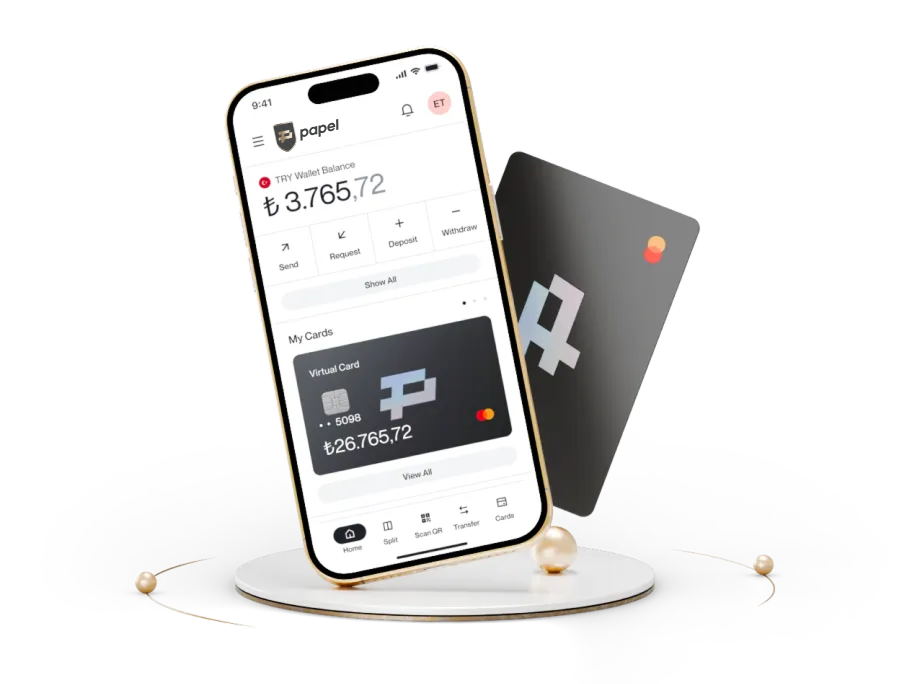Differences Between Virtual POS and Mobile POS: Choose the Best for Your Business
Developed to suit different business models, from physical stores to e-commerce sites, Virtual POS and Mobile POS digitalize the payment collection processes of businesses, providing them with significant advantages. So, what are the differences between these two systems? Which is the best payment solution for your business? A comprehensive guide to the advantages, disadvantages, and suitability of Virtual POS and Mobile POS systems for different companies is available on Papel Blog!
H3: What is Virtual POS?
Virtual POS (Point of Sale) is a digital system that enables businesses to securely receive customer payments online using credit cards, debit cards, or other digital payment methods. Virtual POS, which is particularly preferred by e-commerce sites and businesses providing online services, can be considered the virtual version of a physical POS device.
Easily integrated into online payment platforms and e-commerce sites, Virtual POS systems are equipped with security measures such as SSL certificates and PCI DSS compliance, ensuring that customer information remains protected. Additionally, its multiple payment options and 24/7 availability enhance the customer experience and increase customer satisfaction.
Using Virtual POS to securely and quickly receive payments in a digital environment is very simple. After completing a purchase on an e-commerce site, the customer is directed to the payment page, where they enter their credit or debit card details. The Virtual POS system sends this information to the bank or payment provider for verification. If the payment is approved, the customer and the seller receive a confirmation notification, completing the transaction.
H3: What is Mobile POS?
The Mobile POS system is a point-of-sale system that enables businesses to receive payments via portable devices such as smartphones or tablets. It provides all the functions of traditional POS devices in a more portable and flexible manner.
This mobile payment system is often preferred over traditional POS systems due to its lower cost and lack of additional hardware requirements, providing businesses with the flexibility to accept payments anywhere.
The setup and operation of Mobile POS is straightforward. First, the business owner downloads the payment provider’s app on their smart device and grants the necessary permissions. Once installed, Mobile POS allows customers to make payments via NFC (Near Field Communication) by tapping their card against the device or using QR codes.
After the payment is made, the transaction details are sent to the bank infrastructure via a mobile data network or Wi-Fi. Once the bank approves the transaction, a confirmation is sent to the customer and the seller.
H2: What Are the Key Differences Between Virtual POS and Mobile POS?
There are some key differences between virtual and mobile POS in terms of usage areas and the advantages they provide to businesses. Businesses should evaluate these differences based on their needs before making a choice. Here are the key differences:
H3: Differences in Usage Areas
Virtual POS is a system used to receive payments online. This system lets customers enter their credit or debit card details when shopping online. It is widely used in e-commerce sites, mobile applications, and digital service platforms.
On the other hand, mobile POS is used to receive payments in physical stores or field sales via portable devices. This system, which allows payments via smartphones or tablets, is particularly advantageous for street vendors, couriers, or businesses that operate on the move.
H3: Advantages for Businesses
Virtual POS can be easily integrated into e-commerce platforms and mobile applications. Since it does not require physical hardware, its operational costs are low. Additionally, it enables businesses to sell online 24/7, allowing them to reach a broader customer base.
Mobile POS can be downloaded as an app onto smart devices and does not require additional hardware. Supporting secure payment methods such as NFC, QR codes, and payment links, the Mobile POS system provides businesses with the flexibility to receive payments anywhere, ultimately enhancing customer satisfaction.

H2: What Are the Advantages and Disadvantages of Virtual POS?
Like all payment systems, Virtual POS has several advantages and disadvantages. Let’s examine them together to help you make the right decision for your business.
H3: Advantages of Virtual POS
24/7 Payment Collection: Businesses can receive payments seamlessly 24/7, increasing their sales.
Secure Transactions: SSL and 3D Secure security protocols protect customer information during payments.
Easy Integration: Virtual POS systems can be easily integrated into many e-commerce platforms, providing businesses greater flexibility.
Lower Costs: Virtual POS does not require additional hardware, so it has lower operational costs than physical POS devices.
Multiple Payment Options: Virtual POS supports Visa, Mastercard, and Troy cards, allowing businesses to accept payments from both domestic and international customers.
H3: Disadvantages of Virtual POS
Security Risks: Virtual POS terminals do not require a physical card, making them more vulnerable to fraud. Fraudulent transactions may occur in customer accounts in case of a security breach.
Technical Issues: Payments through Virtual POS may be disrupted due to internet connection problems or server failures, negatively affecting customer satisfaction.
Transaction Fees: Virtual POS providers may charge transaction-based commissions or monthly fees, which can be a disadvantage, particularly for small businesses.
H2: What Are the Advantages and Disadvantages of Mobile POS?
H3: Advantages of Mobile POS
Flexibility & Portability: Businesses can accept payments anywhere, improving sales and customer satisfaction.
Lower Costs: Since Mobile POS does not require a fixed terminal or infrastructure, it is more cost-effective than traditional POS systems, reducing business expenses.
Quick & Efficient Transactions: Mobile POS is designed to speed up payment and refund processes, allowing customers to make payments securely with just one tap.
Secure Payments: Customers can securely pay using their cards or smartphones via NFC or QR codes, especially in hygiene-sensitive situations.
H3: Disadvantages of Mobile POS
Internet Dependency: Since Mobile POS devices rely on Wi-Fi or Bluetooth, accepting payments in areas with weak or no internet connection can be challenging.
Security Risks: Mobile devices may have security vulnerabilities, so keeping security protocols current is essential to prevent fraud.
Technical Problems: Issues like battery life, software updates, or hardware failures can disrupt payment processes.
User Errors: Employees may make errors when using Mobile POS, leading to transaction issues or customer dissatisfaction.

H2: Which One Is More Suitable for Your Business?
Choosing the right POS (Point of Sale) system for your business is essential for optimizing payment processes and enhancing customer satisfaction. Virtual POS and mobile POS cater to different business needs with unique advantages.
Virtual POS is best for e-commerce sites, online education providers, consulting services, and digital service businesses that must accept online payments. Mobile POS is ideal for couriers, restaurants, event vendors, and physical stores that require portable and flexible payment solutions.
Choosing between Virtual POS and Mobile POS depends entirely on your business model and operational needs. If you operate online, Virtual POS is a great option. However, if you run a physical store or offer on-the-go services, Mobile POS will provide greater flexibility.
Sources: 1.

